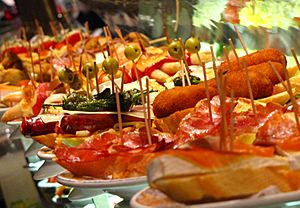Tapas facts for kids

Tapas in Barcelona
|
|
| Course | Appetizer or snack |
|---|---|
| Serving temperature | Hot or cold |
| Main ingredients | Various |
A tapa is a small dish or snack from Spanish cuisine. Think of it like a mini-meal or an appetizer. Tapas can be served cold, like a mix of olives and cheese. They can also be hot, such as chopitos (which are small, fried squid) or patatas bravas (spicy potatoes).
Many people enjoy combining different tapas to create a full meal. In some parts of Central America, similar snacks are called bocas. In Mexico, they are often known as botanas.
What are Tapas?
Tapas are small plates of food. They are usually served with drinks in bars and restaurants. You can find many different kinds of tapas. Some are simple, while others are more fancy.
Tapas are a great way to try many different Spanish foods. You can order a few small dishes and share them with friends. This makes eating tapas a fun social activity.
The Story of Tapas
The word "tapas" comes from the Spanish verb tapar. This verb means "to cover." It's similar to the English word "top."
Long ago, before the 1800s, places like inns and wine bars in Spain served tapas. These places offered food and rooms to travelers. Since many people couldn't read or write back then, the inns would show guests samples of their food. They would put these samples on a "tapa," which was a pot cover.
One popular story says that early tapas were thin slices of bread or meat. People drinking sherry wine in taverns used these slices to cover their glasses. This kept fruit flies from getting into the sweet sherry. The meat used was often salty ham or chorizo sausage. These salty foods made people thirsty, so they would drink more. Because of this, bar owners started making many different snacks to serve with drinks. This helped them sell more drinks. Over time, tapas became just as important as the drinks themselves.
Tapas have changed a lot over the years. New ingredients and ideas have been added. For example, the Romans came to Spain a long time ago. They brought new ways to grow olives and use water for farming. Later, when the New World (the Americas) was discovered, new foods arrived in Spain. These included tomatoes, peppers, corn, and potatoes. These new foods were easy to grow in Spain and quickly became part of tapas.
Spain even has special competitions for tapas. There is one big National Tapas competition every November. Since 2008, there's also been an International Tapas Competition for Culinary Schools. Students from cooking schools around the world come to Spain to create the best new tapa ideas.
Where Did Tapas Begin?
The main meaning of tapa is "cover" or "lid." But in Spain, it also means this type of food. No one is completely sure how this food meaning started. But there are a few popular ideas:
- One story says that King Alfonso X of Castile was sick. He got better by drinking wine with small dishes between meals. After he was well, the king ordered that no tavern could serve wine without a small snack or "tapa" to go with it.
- Another popular story is about King Alfonso XIII. He stopped at a famous tavern in Cádiz, a city in Andalusia. He ordered a glass of wine. The waiter covered the glass with a slice of cured ham. This was to protect the wine from the beach sand, as Cádiz can be windy. The king drank his wine and ate the ham. Then he ordered another wine "with the cover."
See also
 In Spanish: Tapa (alimento) para niños
In Spanish: Tapa (alimento) para niños


